
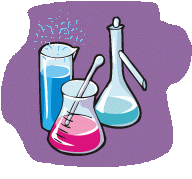

A highly energetic peroxo complex of chromium
In this experiment, a neutral complex of the element chromium is made, which has the metal in its +4 oxidation state, which is very unusual for this metal. This complex is remarkably energetic and burns like flash powder, even without any fuel, when it is ignited.
The complex is chromium(IV) triammine diperoxide, Cr(NH3)3(O2)2.


This experiment must be carried out with great care, and only small quantities must be used. Do not scale up the experiment. In this experiment hexavalent chromium is used, which is a carcinogen. The peroxo complex also must be considered a carcinogen, probably it is even more carcinogenic than hexavalent chromium compounds. Another serious risk is explosion or very violent deflagration of the peroxo complex. This complex is impact sensitive and friction sensitive. Do not make more than amounts in the order of magnitude of 100 mg.
![]()
![]() Required
chemicals:
Required
chemicals:
-
ammonium chromate (ammonium dichromate also can be used)
-
ammonia (25%)
-
hydrogen peroxide
-
ethanol (96%)
-
diethyl ether (optional)
![]() Required
equipment:
Required
equipment:
-
test tubes
-
petri dish
![]() Safety:
Safety:
- ammonia (25%) is corrosive and gives off very pungent gas.
- ammonium chromate is a carcinogen and easily forms dust in the air, be careful not to inhale some of the dust.
- ethanol is flammable
- ether is very flammable
- consider the solid end-product, made in this experiment, as a very toxic and explosive compound.
![]() Disposal:
Disposal:
- All toxic waste must be neutralized with a 10% solution of hydrochloric acid, to which some sodium sulfite is added. In this way, all chromium is reduced to the +3 oxidation state. After neutralization, the waste can be flushed down the drain with a lot of water. The amount of chromium, used in this experiment only is small (150 mg or so).
![]()
Preparation of the compound
![]() Take a spatula, full of ammonium (di)chromate (250 mg or so)
and dissolve this in as little as possible concentrated ammonia. It is
remarkable how much ammonia is needed. The ammonium chromate does not dissolve
easily. Chill the solution in a tub of cold water. The temperature of the water
should be between 5 ºC and 10 ºC. When all is dissolved, then an intensely
golden yellow solution is obtained.
Take a spatula, full of ammonium (di)chromate (250 mg or so)
and dissolve this in as little as possible concentrated ammonia. It is
remarkable how much ammonia is needed. The ammonium chromate does not dissolve
easily. Chill the solution in a tub of cold water. The temperature of the water
should be between 5 ºC and 10 ºC. When all is dissolved, then an intensely
golden yellow solution is obtained.
![]() Take 3
ml of 30% hydrogen peroxide and also chill this in the cold water.
Take 3
ml of 30% hydrogen peroxide and also chill this in the cold water.
![]() Slowly
add the hydrogen peroxide. After each half ml, swirl the test tube in the cold
water, such that it remains cold. Also, after adding each half ml of hydrogen
peroxide, put a dash of cotton wadding or paper tissue in the open end of the
test tube. This assures that gas can go through, but little droplets of
liquid, which are spraying from the solution are absorbed by the cotton wadding
or paper tissue. After adding hydrogen peroxide, the solution darkens and
becomes dark brown.
Slowly
add the hydrogen peroxide. After each half ml, swirl the test tube in the cold
water, such that it remains cold. Also, after adding each half ml of hydrogen
peroxide, put a dash of cotton wadding or paper tissue in the open end of the
test tube. This assures that gas can go through, but little droplets of
liquid, which are spraying from the solution are absorbed by the cotton wadding
or paper tissue. After adding hydrogen peroxide, the solution darkens and
becomes dark brown.
![]() After
adding the last amount of hydrogen peroxide, let the test tube stand in the tub
with cold water for half an hour. In this time, many tiny crystals of a
red/brown compound are formed. The solution also keeps on bubbling, but this is
going slower and slower. After half an hour, the bubbling is very slow.
After
adding the last amount of hydrogen peroxide, let the test tube stand in the tub
with cold water for half an hour. In this time, many tiny crystals of a
red/brown compound are formed. The solution also keeps on bubbling, but this is
going slower and slower. After half an hour, the bubbling is very slow.
After this half an hour, a fairly large amount of a fine brown crystalline precipitate is formed. It is hard to see the crystalline precipitate in the dark brown liquid, but when the liquid is decanted carefully, then the precipitate is revealed.
Don't wait too long with cleaning of the compound. It seems that the material is unstable in aqueous solution and waiting too long may result in decomposition of all of the material.
![]()
Cleaning of the compound
![]() The liquid must be decanted from the precipitate as good as
possible.
The liquid must be decanted from the precipitate as good as
possible.
![]() To the wet precipitate, add a few ml of 96% ethanol and swirl
well. The ethanol becomes turbid and yellow. Let the brown precipitate settle
again (this only takes a few tens of seconds) and then decant the turbid yellow
liquid.
To the wet precipitate, add a few ml of 96% ethanol and swirl
well. The ethanol becomes turbid and yellow. Let the brown precipitate settle
again (this only takes a few tens of seconds) and then decant the turbid yellow
liquid.
![]() Perform
a second rinse with ethanol. This second rinse only is slightly turbid, white or
pale yellow. If no ether is available, then perform a third and optionally a
fourth rinse.
Perform
a second rinse with ethanol. This second rinse only is slightly turbid, white or
pale yellow. If no ether is available, then perform a third and optionally a
fourth rinse.
![]() If ether
is available, then after two rinses with ethanol, perform two rinses with ether.
After the second rinse of ether, a perfectly clear liquid can be decanted from
the fine brown crystals and this can be dried.
If ether
is available, then after two rinses with ethanol, perform two rinses with ether.
After the second rinse of ether, a perfectly clear liquid can be decanted from
the fine brown crystals and this can be dried.
The picture below shows the result after the two rinses with ethanol and ether. This material now must be allowed to dry.
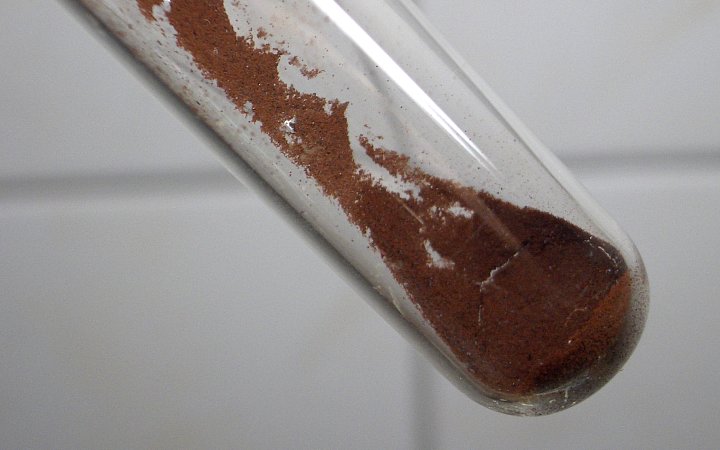
![]() Spread
the contents of the test tube in a petri dish and put this disk in a warm dry
place. If ether was used for rinsing, then the material is perfectly dry after
approximately 30 minutes. If ethanol was used for the last rinse, then the
drying takes longer. In that case let the material sit in the petri dish for one
day, at a dry warm place (e.g. above a radiator from a central heating system).
Spread
the contents of the test tube in a petri dish and put this disk in a warm dry
place. If ether was used for rinsing, then the material is perfectly dry after
approximately 30 minutes. If ethanol was used for the last rinse, then the
drying takes longer. In that case let the material sit in the petri dish for one
day, at a dry warm place (e.g. above a radiator from a central heating system).
The final result after drying is a fine crystalline red/brown powder, which is perfectly dry and non-hygroscopic. It is interesting to compare this material with another chromium peroxo complex, K3Cr(O2)4. The other complex is much darker, and the crystals also are larger.
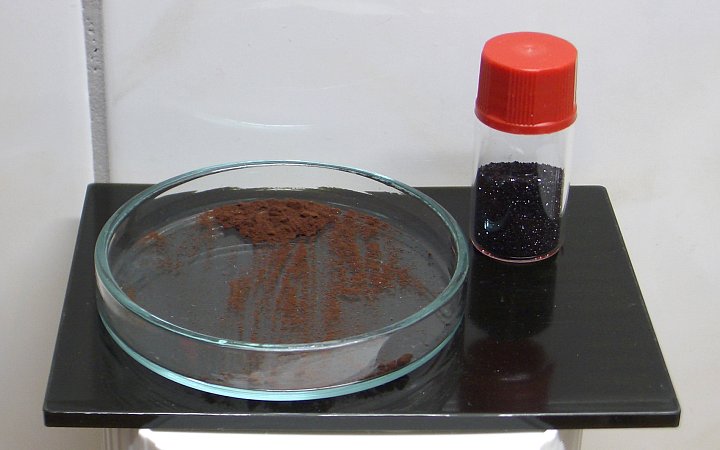
A close up of the brown powder is given in the picture below.
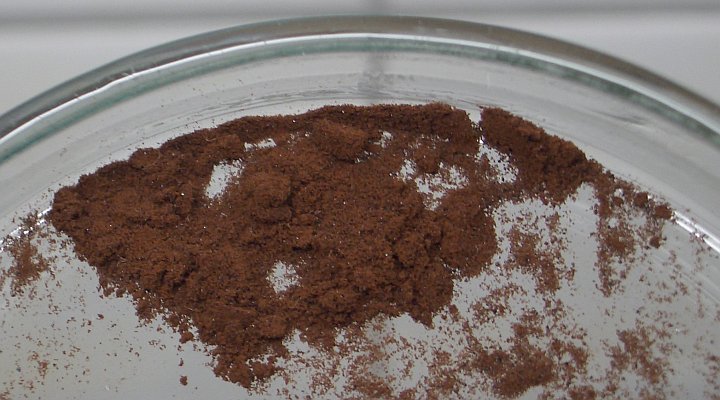
The material is weighed and transferred to a miniature glass vial, which is loosely capped. The total yield is approximately 120 mg, while the starting material was appr. 250 mg of ammonium chromate, with a large excess of ammonia and hydrogen peroxide. This is a yield of approximately 40%, yield based on amount of ammonium chromate used. Most likely the yield can be increased quite much, but in this experiment the goal simply was making some of this chromium ammine-peroxo complex and no effort was made to create optimal conditions for good yield.
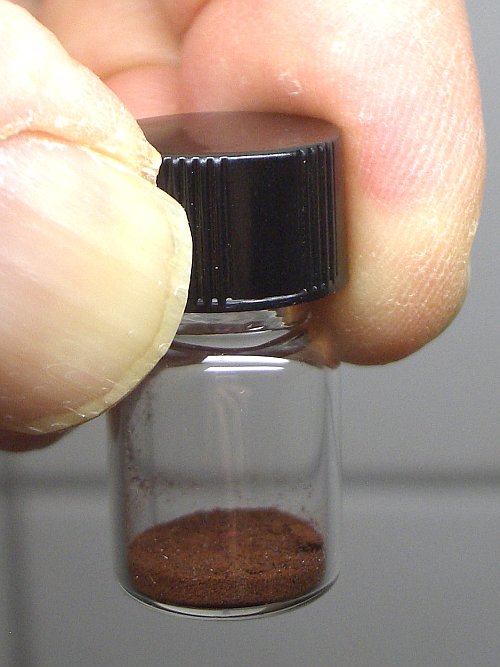
When one is looking at the powder from a smaller distance, then one can clearly see that it is crystalline. The material is glittering.
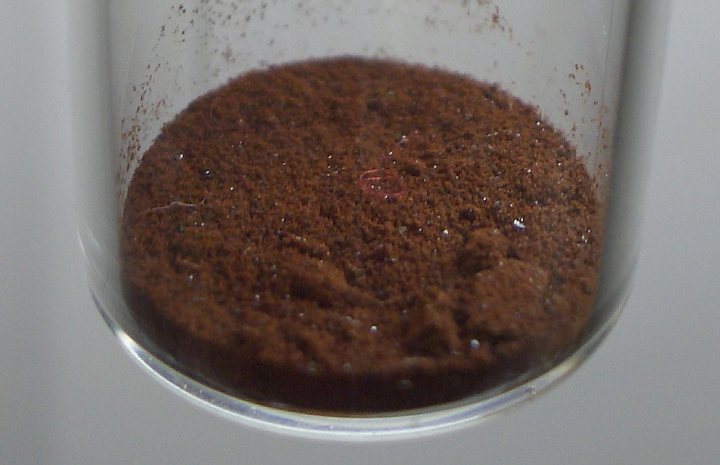
At first glance, the solid material seems to be stable. It does not loose ammonia. When a spatula with some of the solid is kept near an open bottle of hydrochloric acid, then no white smoke of ammonium chloride can be observed. However, long-term storage of the material shows that it is not really stable. It decomposes, albeit slowly.
![]()
Some properties of the compound
![]() When the solid is added to water, then it dissolves very
slowly, giving a brown/yellow solution, which develops oxygen all the time. So,
it seems that the material is unstable and decomposes in solution. After longer
standing, the solution becomes yellow, due to formation of chromate and free
ammonia is also present. The ammonia can be detected easily, white smoke is
produced when concentrated hydrochloric acid is kept nearby.
When the solid is added to water, then it dissolves very
slowly, giving a brown/yellow solution, which develops oxygen all the time. So,
it seems that the material is unstable and decomposes in solution. After longer
standing, the solution becomes yellow, due to formation of chromate and free
ammonia is also present. The ammonia can be detected easily, white smoke is
produced when concentrated hydrochloric acid is kept nearby.
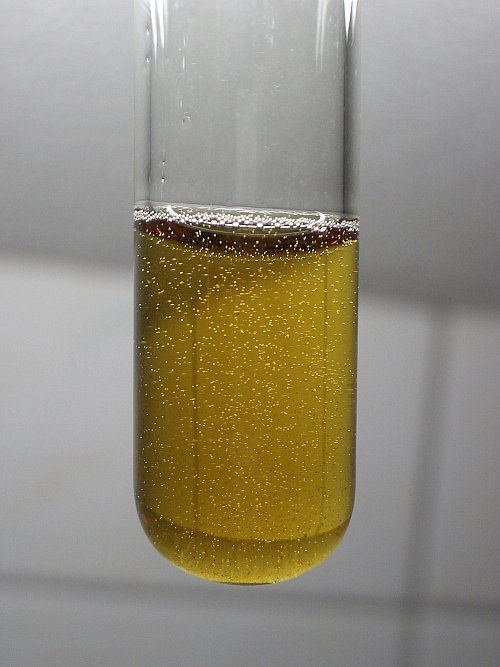
The decomposition most likely occurs as follows:
2Cr(NH3)3(O2)2 + H2O → 4NH4+ + 2CrO42- + 2NH3 + O2
![]() When the above solution is acidified with some hydrochloric
acid, then it quickly becomes green/yellow, after a very short not-very
pronounced soft blue/grey transient. The picture below shows the green/yellow
color, the white smoke, due to the presence of free ammonia, and the formation
of oxygen.
When the above solution is acidified with some hydrochloric
acid, then it quickly becomes green/yellow, after a very short not-very
pronounced soft blue/grey transient. The picture below shows the green/yellow
color, the white smoke, due to the presence of free ammonia, and the formation
of oxygen.
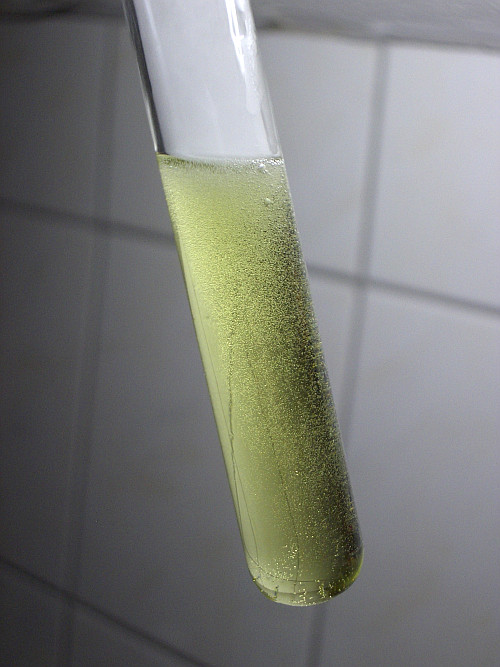
The green/yellow color is due to a mix of chromium(III) and dichromate.
![]() When the solid material is added to a 10% solution of
hydrochloric acid, then the material starts fizzling and quickly all of it is
converted to green chromium(III). The picture below shows the result of adding a
pinch of the solid material to a micro-bowl, filled with 10% hydrochloric acid.
When the solid material is added to a 10% solution of
hydrochloric acid, then the material starts fizzling and quickly all of it is
converted to green chromium(III). The picture below shows the result of adding a
pinch of the solid material to a micro-bowl, filled with 10% hydrochloric acid.
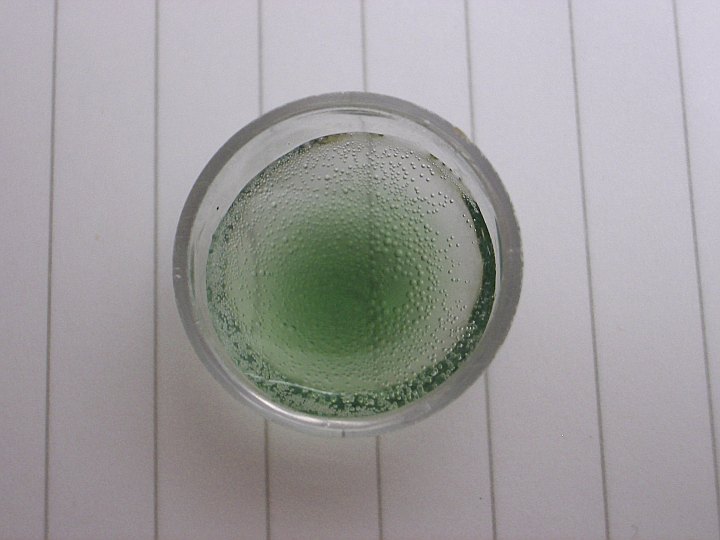
Decomposition of the material in acidic media is through formation of an intermediate blue peroxo complex and splitting off ammonia, which is converted to ammonium ion.
![]() When the
solid material is heated above a flame, then it starts burning very violently.
Ignition is remarkably easy, just keeping it near a flame causes it to ignite
and it burns very fast, like flash powder. The light output, however, is
somewhat lower than the light output of true flash powder. The two pictures
below show the burning of the solid in a bright flash, and the dark green/grey
smoke, produced afterwards.
When the
solid material is heated above a flame, then it starts burning very violently.
Ignition is remarkably easy, just keeping it near a flame causes it to ignite
and it burns very fast, like flash powder. The light output, however, is
somewhat lower than the light output of true flash powder. The two pictures
below show the burning of the solid in a bright flash, and the dark green/grey
smoke, produced afterwards.
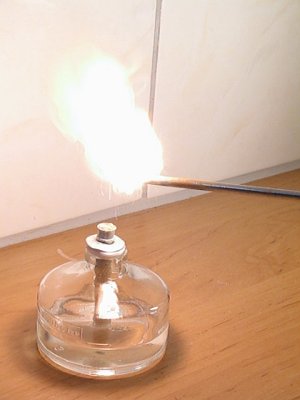
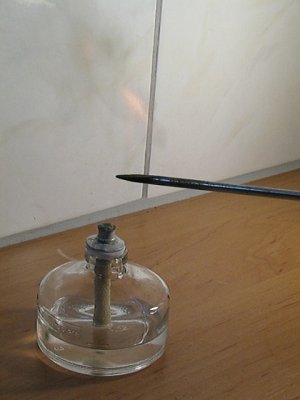
After the burning of the material, a piece of damp paper tissue was used to wipe off the surface of the bench, on which the burner was standing. The result of burning is green.
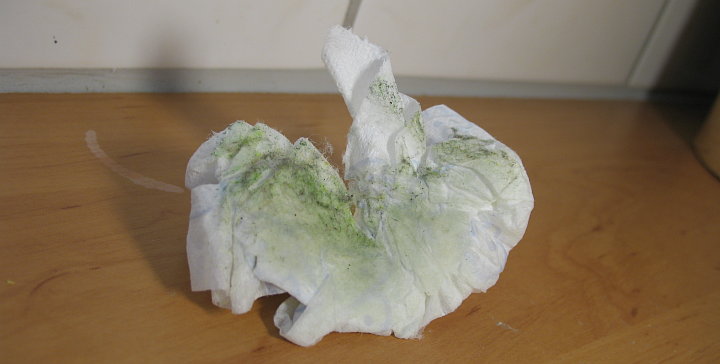
The violent burning is an internal oxidation/reduction, where part of the ammonia ligands are oxidized by the peroxo ligands, with release of water and nitrogen. The chromium is converted to chromium(III) oxide.
A video of the burning material is available here, download size is 478 KByte.
![]()
Decomposition on storage, the same material 4 weeks later
When the material was prepared, it seemed to be stable, but after 4 weeks of storage at room temperature, the material has decomposed. Its color has shifted from brown to yellow, and in the yellow material there are many tiny dark specks. The material also lost its energetic properties. It does not burn like flash powder anymore, although it still burns nicely. The burning of the decomposed material actually looks cute, as is demonstrated by two videos.
After 4 weeks, the material in the little bottle looks as follows:
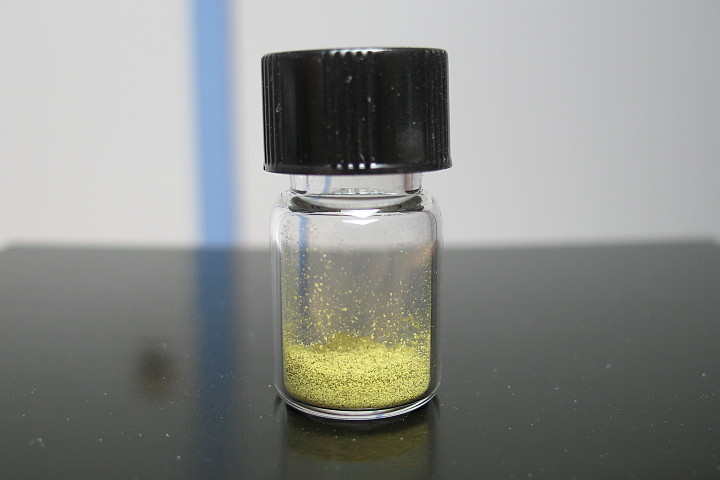
The burning of the material is shown in the three pictures below:
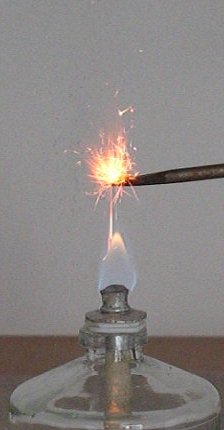
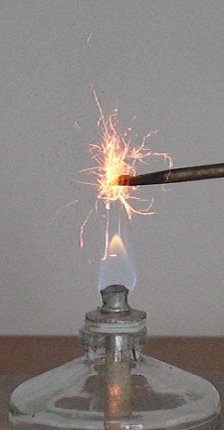
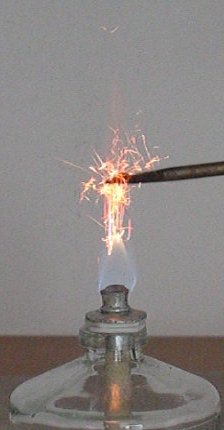
It slowly burns, and it needs the heat of the flame. When the material is taken out of the flame, then the burning stops. Most likely, when a large amount of the material is ignited, then the fire will be self-sustained. The small quantity used in this experiment looses too much heat for self-sustained fire.
Two videos can be downloaded. One is burning in a dimly lit room, the other is burning in a much lighter room. Download size of both videos is approximately 2.5 MByte.
![]()
Discussion of results
The conversion of the chromate to the triammine peroxo complex is according to the following equation.
CrO42– + 3NH3 + 3H2O2 → Cr(NH3)3(O2)2 + 2H2O + 2OH– + O2
Three molecules of hydrogen peroxide are used for each chromate ion. Two molecules provide the peroxo ligand, and one molecule of hydrogen peroxide is used to reduce the chromium from the +6 oxidation state to the +4 oxidation state. The hydrogen atoms from the hydrogen peroxide molecules go into water and hydroxide ions, where the oxygen comes from the chromate ion.
The material slowly decomposes and is converted to ammonium chromate, which explains the dirty yellow color after 4 weeks of storage. On decomposition some of the chromium is reoxidized to the +6 oxidation state, but most likely, part of it is converted to chromium(III) as well. This could explain the somewhat off-yellow color of the decomposed product, it is not a bright yellow or golden yellow color, as one would expect for a chromate.
Remark: The information about the red/brown compound is from the book "Chemistry of the Elements, third edition", page 1025, from Greenwood and Earnshaw. This page states that this compound can be made by treating an ammoniacal solution of ammonium chromate with hydrogen peroxide, or by decomposing tetraperoxochromate(V) ion with warm ammonia. In this experiment, the first route of synthesis is used. There is, however, a lot of confusion about the plethora of peroxo compounds, which can be made from chromates and hydrogen peroxide.